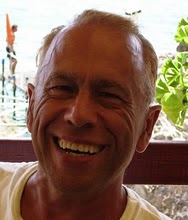I often use points of the Heart channel for lower backache, particularly in men. The reason is the same as that given for the use of these points for men's sexual problems: the Heart is like an "Upper Kidney" and it therefore naturally influences the lower back. I find that the point HE-7 Shenmen is the best for this function because, besides its indirect action on the Kidney channel (and therefore the lower back), it also has a general anti-spastic effect, thus relaxing the muscles. I usually combine this point with the opening points of the Du Mai (only if the pain stems from the spine area).
An example of a combination in a man would be SI-3 Houxi on the left, BL-62 Shenmai on the right, HE-7 Shenmen on the right and KI 4 Dazhong on the left. If the pain is unilateral, I use KI-4 Dazhong on the side of the pain and HE-7 Shenmen on the opposite side.
Nausea, Vomiting
Although nausea and vomiting are always related to Stomach-Qi ascending instead of descending, Heart-Qi also has (or should have) a descending movement. The "Explanation of Acupuncture Points" says: "When Heart-Qi rebels upwards there is belching or vomiting: this means that Heart-Qi is full; tonifying the Water point [HE-3 Shaohai] will make Qi descend". The same also specifically recommends it for nausea and vomiting. The same text also recommends HE-5 Tongli for vomiting of bitter fluids and HE-7 Shenmen for vomiting of blood. The "Great Dictionary of Chinese Acupuncture" mentions also HE-6 Yinxi for vomiting of blood and HE-1 Jiquan for dry vomiting.
Furthermore, the Heart channel is closely related to the epigastrium; in fact, in the old times, the distinction between Heart pain and Epigastric pain was somewhat blurred. Incidentally, this is borne out by modern medicine too when symptoms of incipient cardiac infarction may often resemble indigestion.
Thus, if Heart-Qi ascends rather than descend, nausea and vomiting may ensue (which incidentally may also occur in the prodromal stage of a heart infarction). This is probably the reason why P-6 Neiguan (acting on the Heart) is such an important point for nausea and vomiting. From the Heart channel, HE-5 Tongli is the best point, and also Ren-15 Jiuwei or Ren-14 Juque both of which act on the Heart.
Calm Nerves in Asthma
Points of the Heart channel can be used to treat acute attacks of asthma. This is probably due to their anti-spastic action and they presumably relax the bronchial muscles and therefore relieve broncho constriction. Thus, in this case, Heart point are not used to "calm the Mind" but to relax the bronchial muscles.
The main point used is HE-7 Shenmen, usually in combination with Du-24 Shenting and Ren-15 Jiuwei (which relaxes the chest and acts on the Heart). The "Explanation of Acupuncture Points" recommends HE-7 Shenmen for rebellious Qi and Heart-Fire causing breathlessness. Heart points also help asthma because they help to restore the descending of Qi in the chest. The "Great Compendium of Acupuncture" recommends HE-7 Shenmen, SP-9 Yinlingquan, BL-60 Kunlun and GB-41 Zulinqi for breathlessness.
Tremors
Heart points can be used to alleviate tremors in Parkinson's disease. They have an effect on tremors for two reasons: first, through the anti spastic effect mentioned above; secondly, because Heart points will nourish Yin in the arm and will help to alleviate tremors of the arm (since Wind, especially in old people, derives from Yin deficiency). The main points are HE-7 Shenmen, HE-6 Yinxi and HE-5 Tongli. The "Great Dictionary of Chinese Acupuncture" recommends the point HE-3 Shaohai for contracture of the hand and numbness of the arm.
When treating the tremor of Parkinson, I would advise in any case not using too many Yang points on the arm as Yang corresponds to movement. Thus, I would balance the Yang points with some from Yin channels and especially those from the Heart channel.
Interestingly, the extra point for tremors called Xiaochanxue (Stopping Tremor Point) is located on the Heart channel (1.5. cun below HE-3 Shaohai).
The best point is HE-5 Tongli. The Su Wen mentions a combination for swollen and painful knee: SI-2 Qiangu, HE-8 Shaofu, KI-2 Rangu and BL-66 Tonggu. The Heart points affect the knee firstly because of the relationship with the Kidney channel and secondly, because Heart points can be used to clear Heat and cool Blood in general. I have tried this combination many times and it works. In my experience, it is best when the knee is inflamed and swollen.
Eye
Both the Heart main and Luo channels flow to the eye and Heart points can therefore be used for eye problems, especially from inflammation. The best point is HE-5 Tongli. In fact the "Explanation of Acupuncture Points" recommends HE-5 Tongli for painful and red eye (from Heart-Fire) and HE-7 Shenmen for yellow and painful eye.
Urinary Problems
The Heart channel points can be used for urinary problems due to its connection with the Bladder channel through the Small Intestine channel. In fact, the Heart is exteriorly-interiorly connected to the Small Intestine and this, in turn, has an Above-Below connection with the Bladder channel within the Tai Yang channels. The Heart channel is particularly used for Lin urinary problems from Heart-Heat transmitting to the Small Intestine and Bladder, and the main point is HE-8 Shaofu, in combination with SI-2 Qiangu, BL-66 Tonggu. Sometimes Heart-Fire combines with Liver-Fire to cause urinary problems and the main points are HE-8 Shaofu and LIV-2 Xingjian. The "Explanation of Acupuncture Points" recommends HE-8 Shaofu (with reducing method) for urinary problems.








